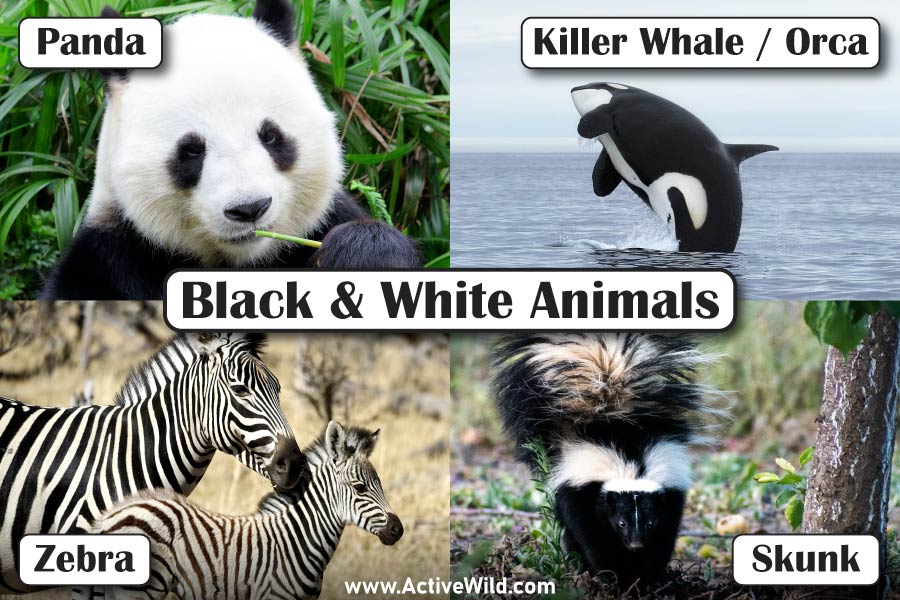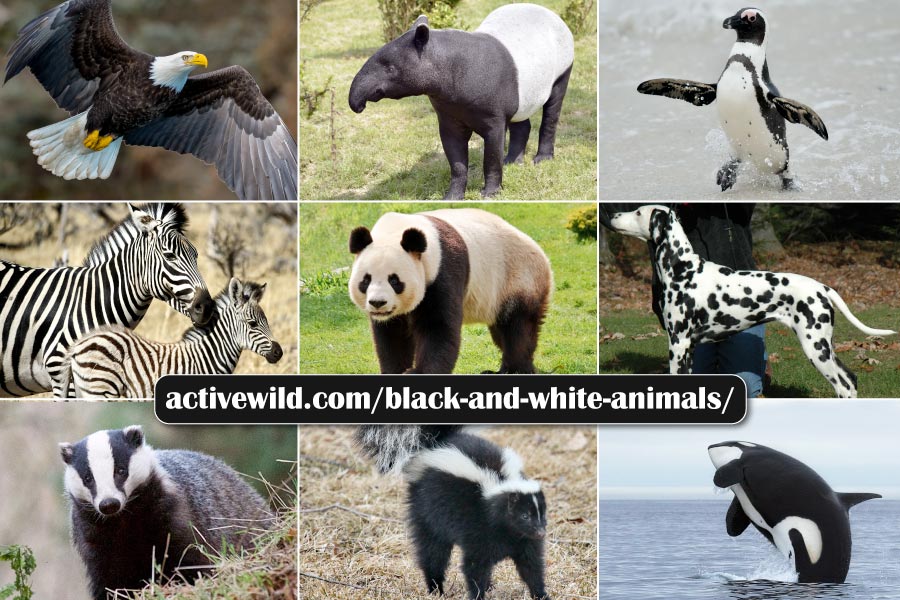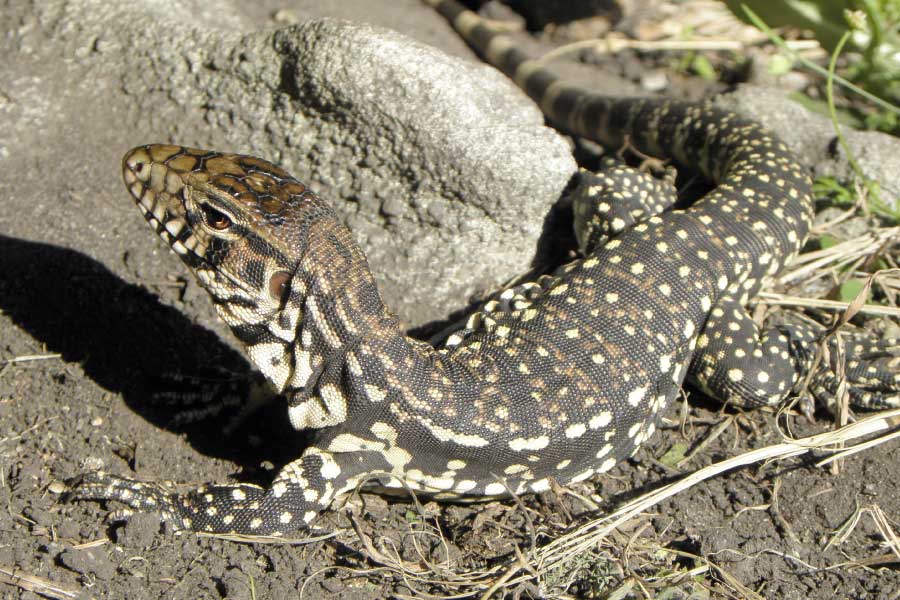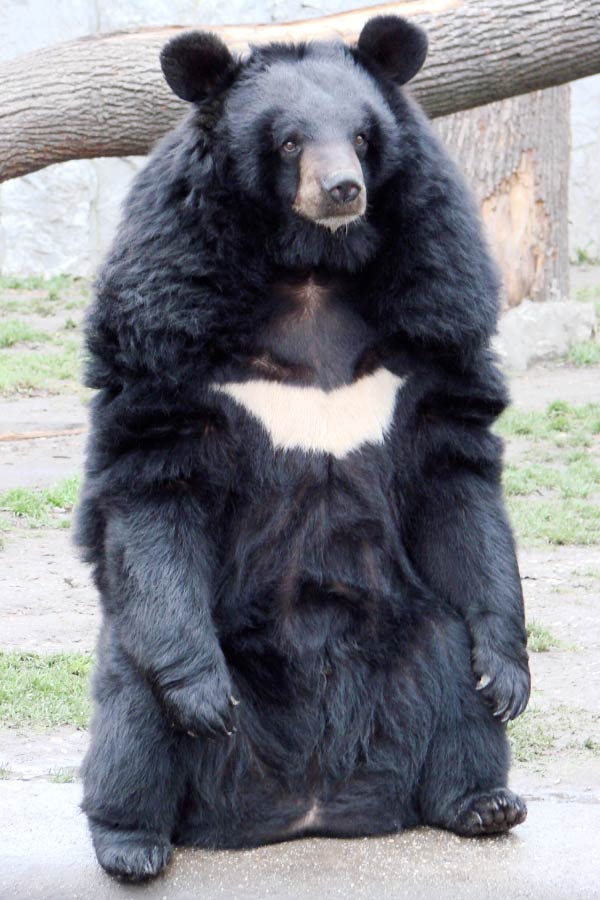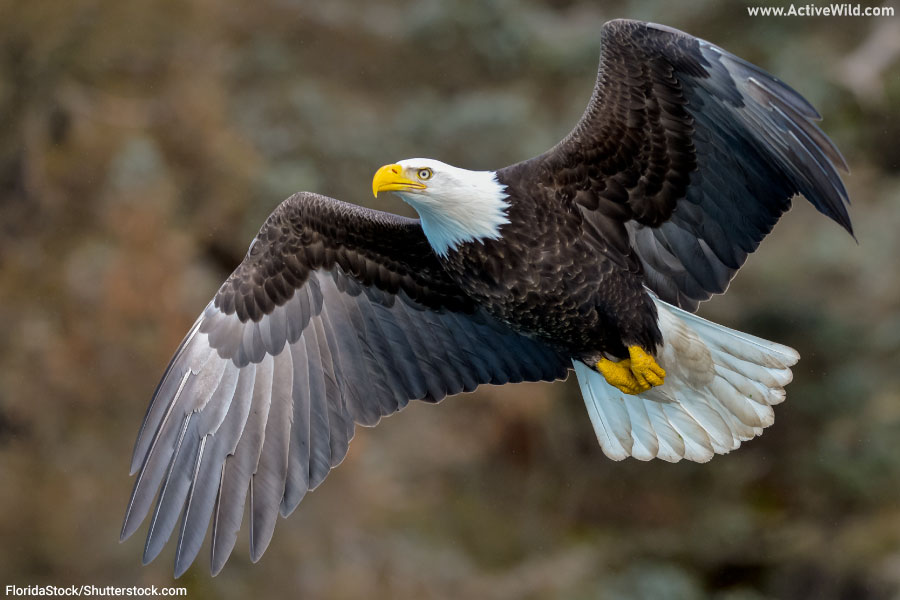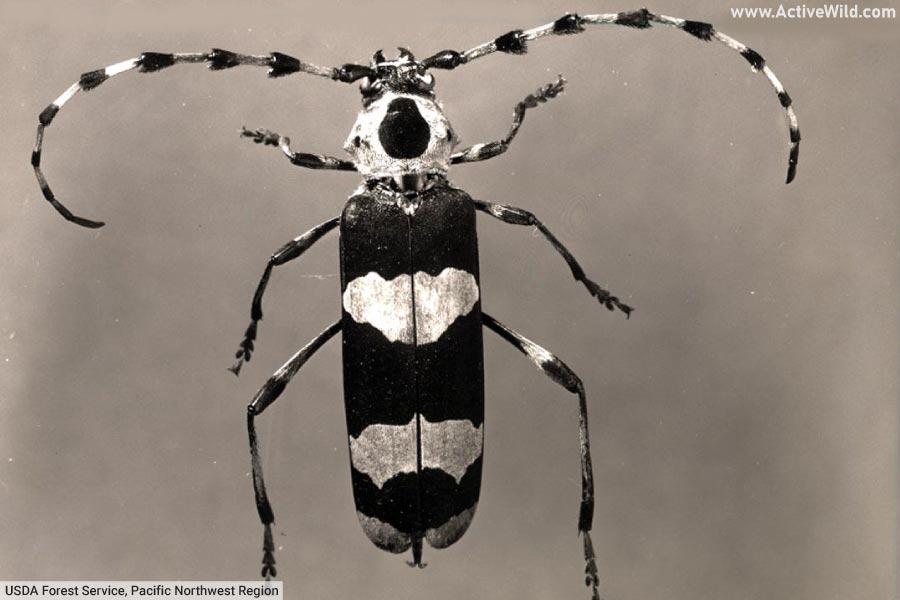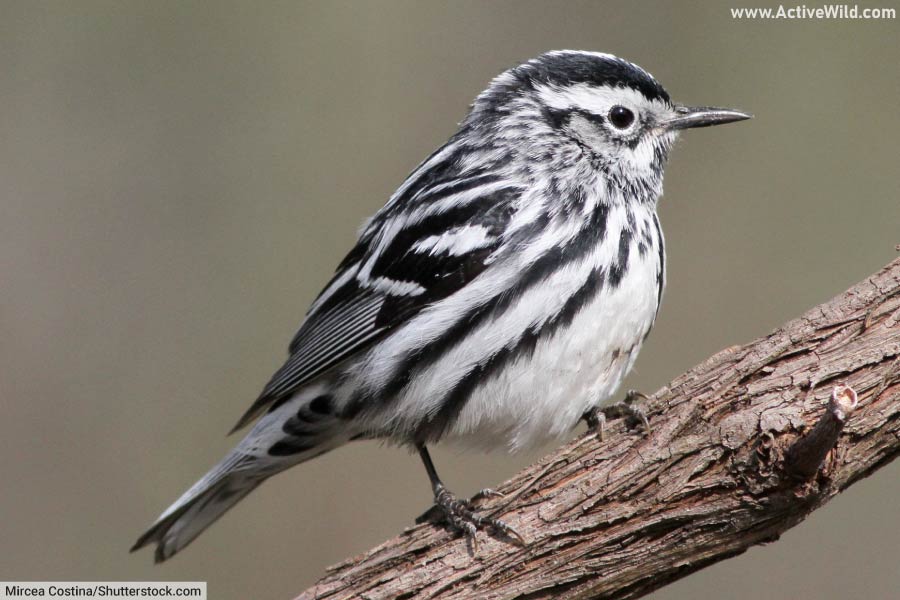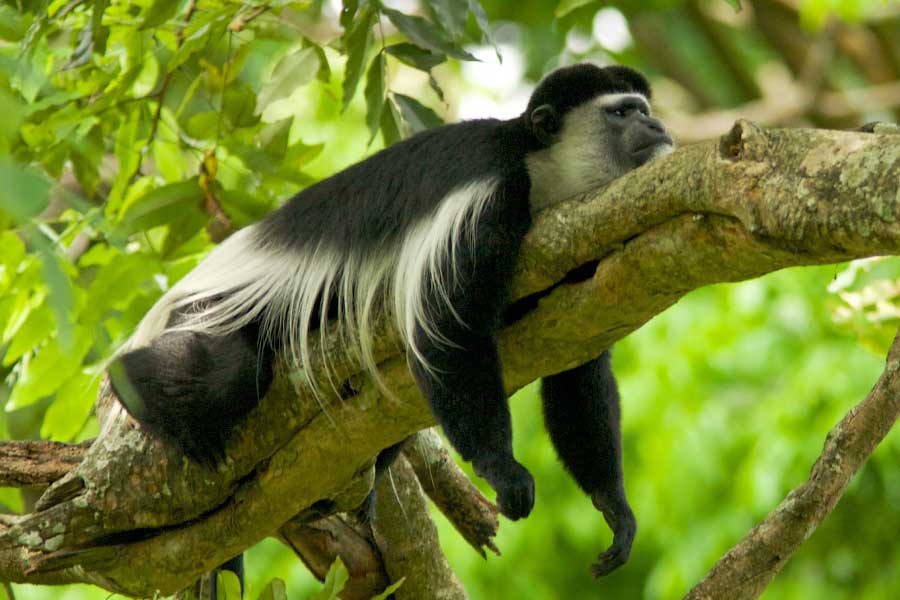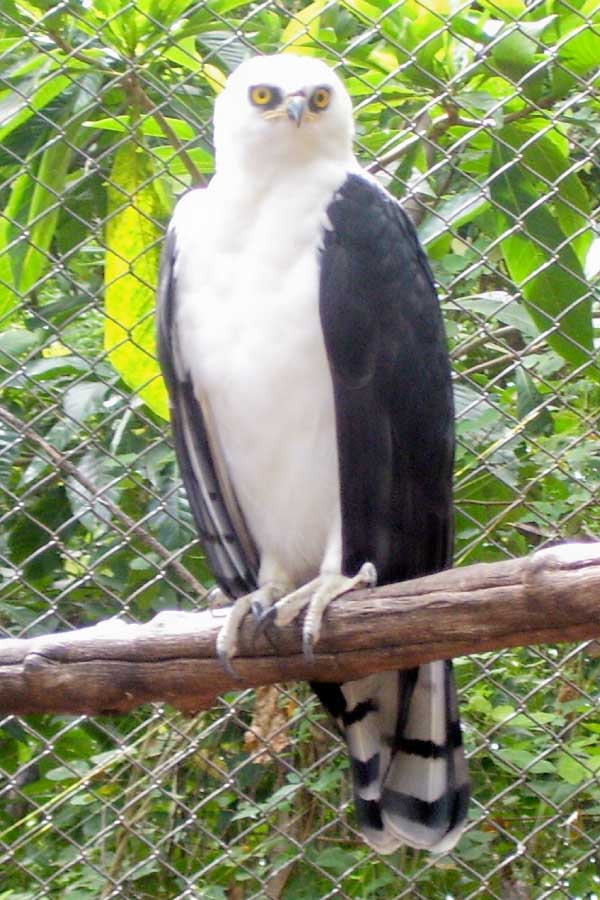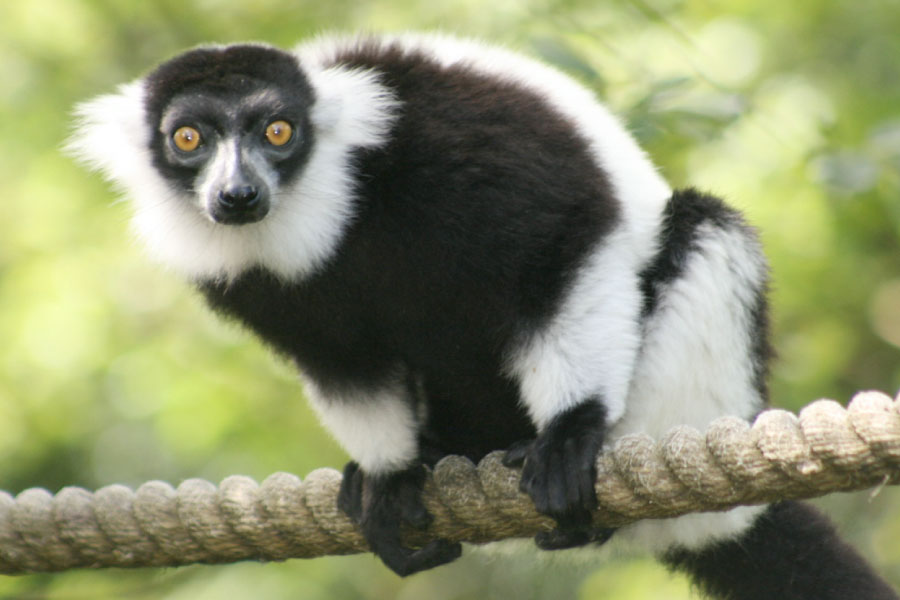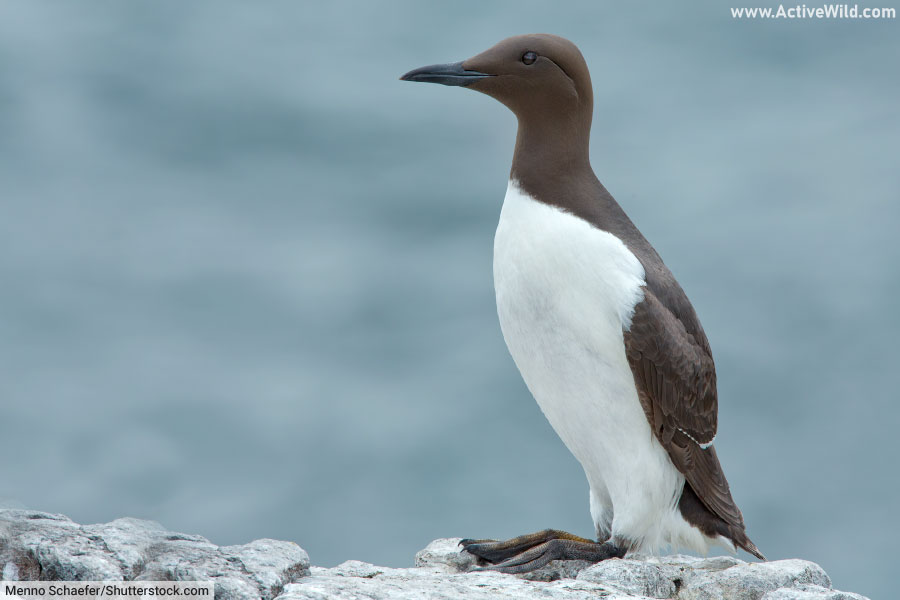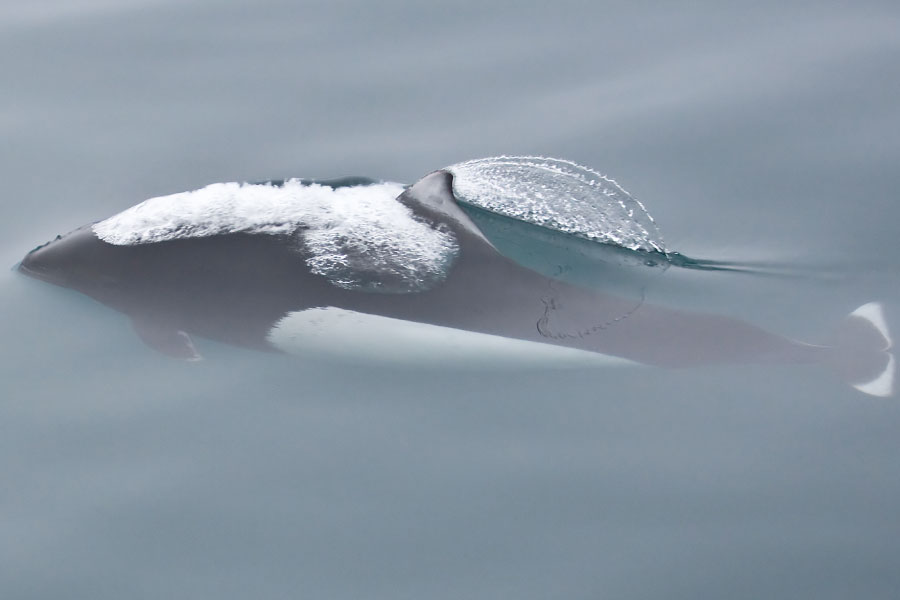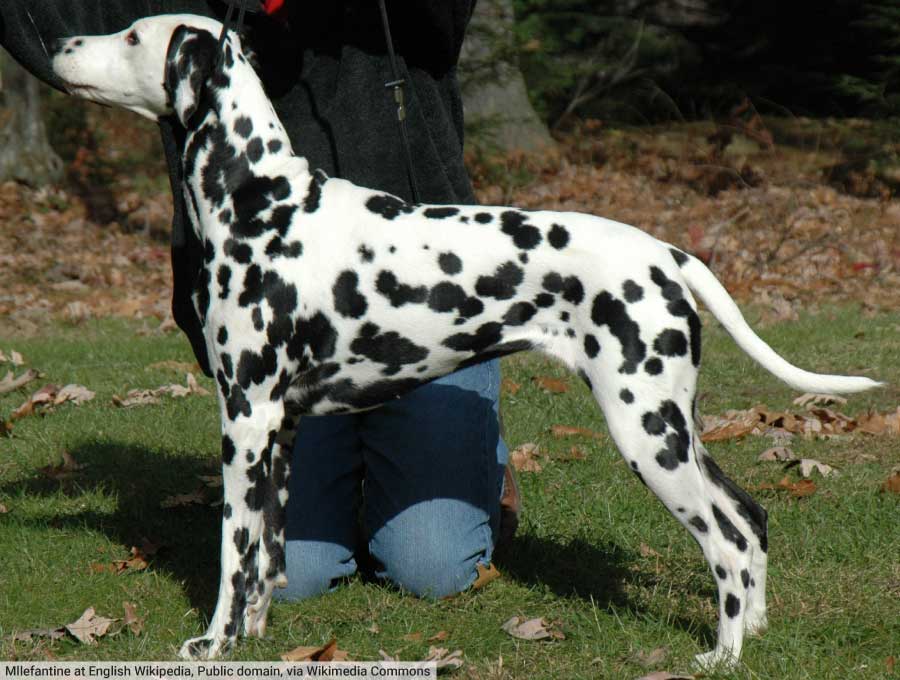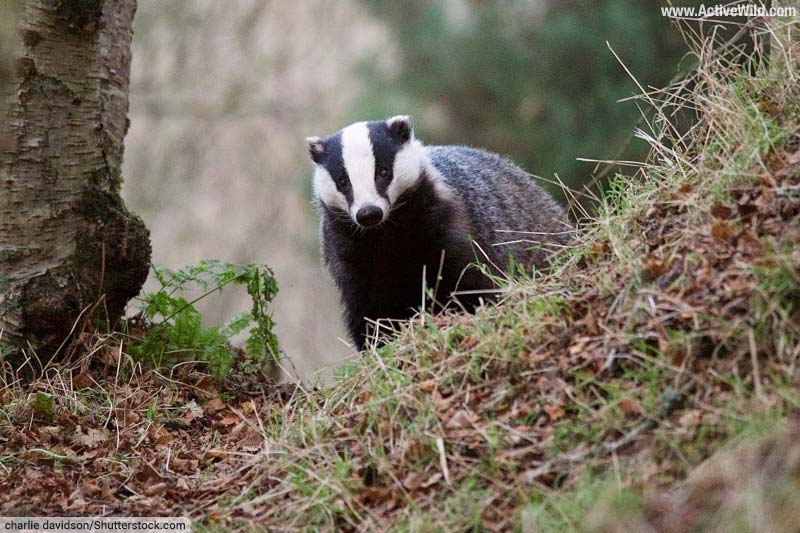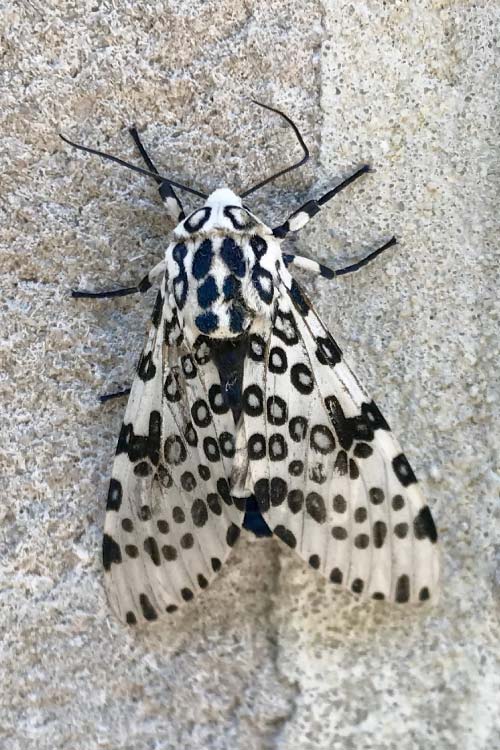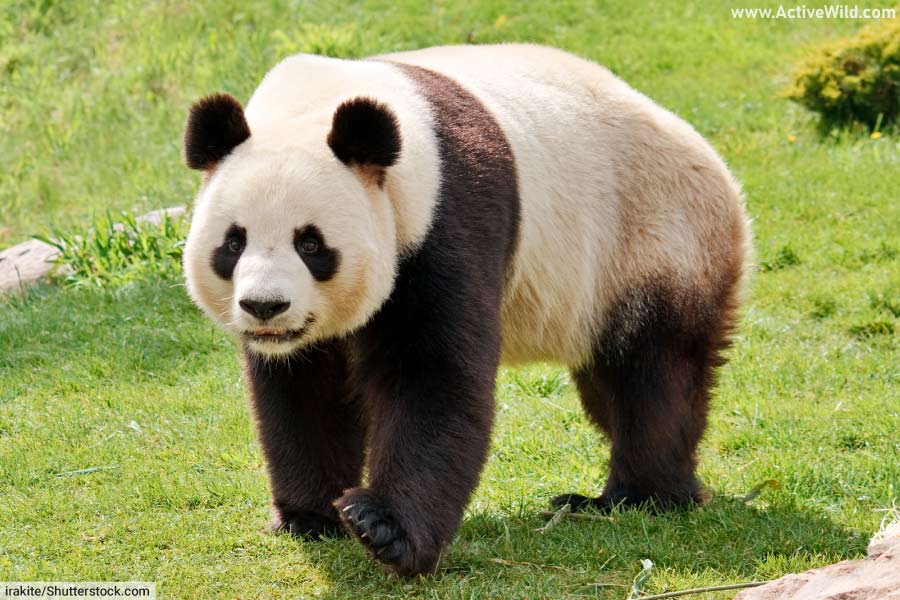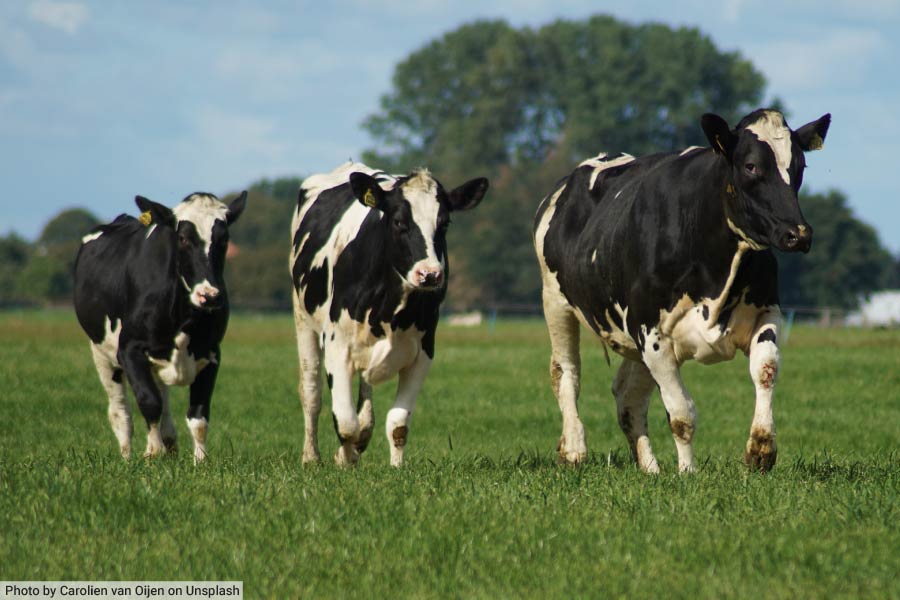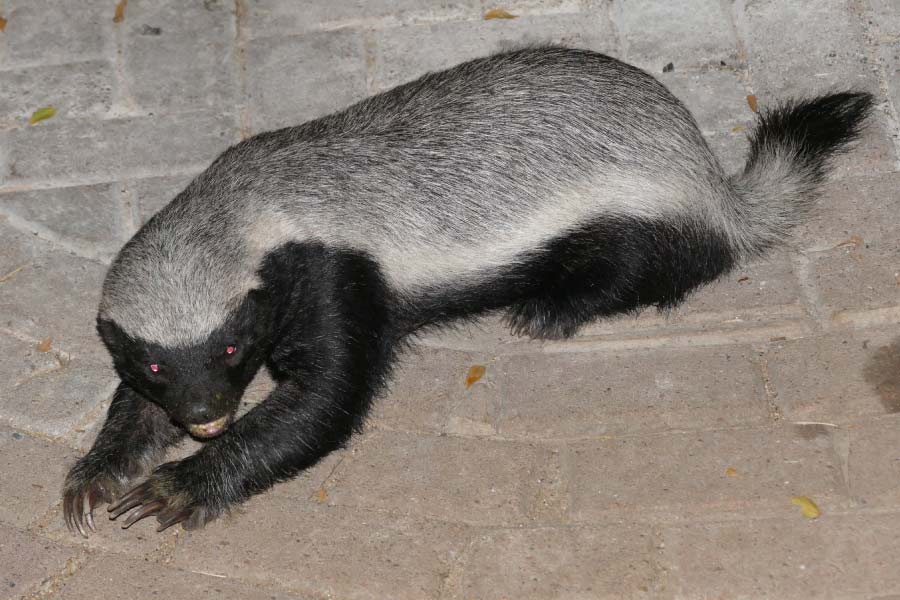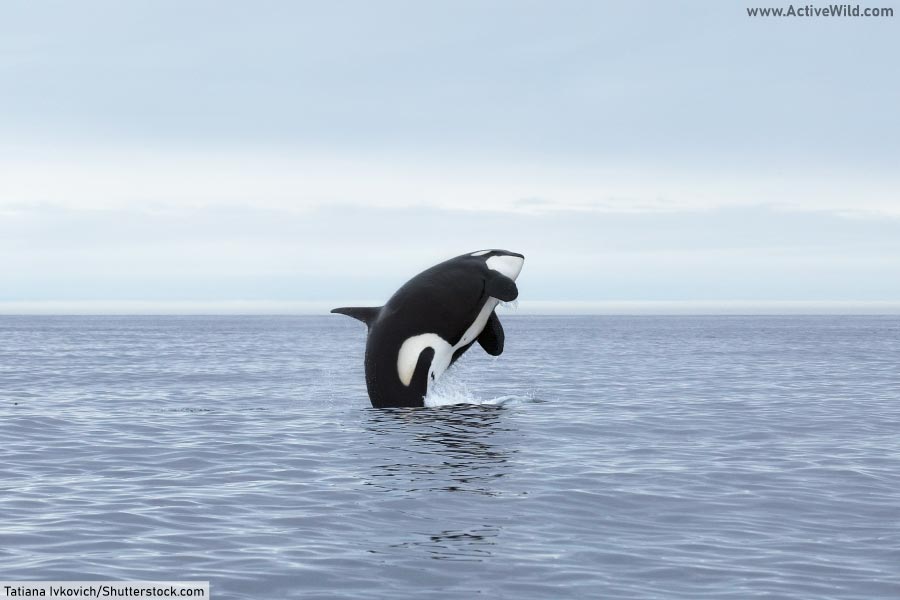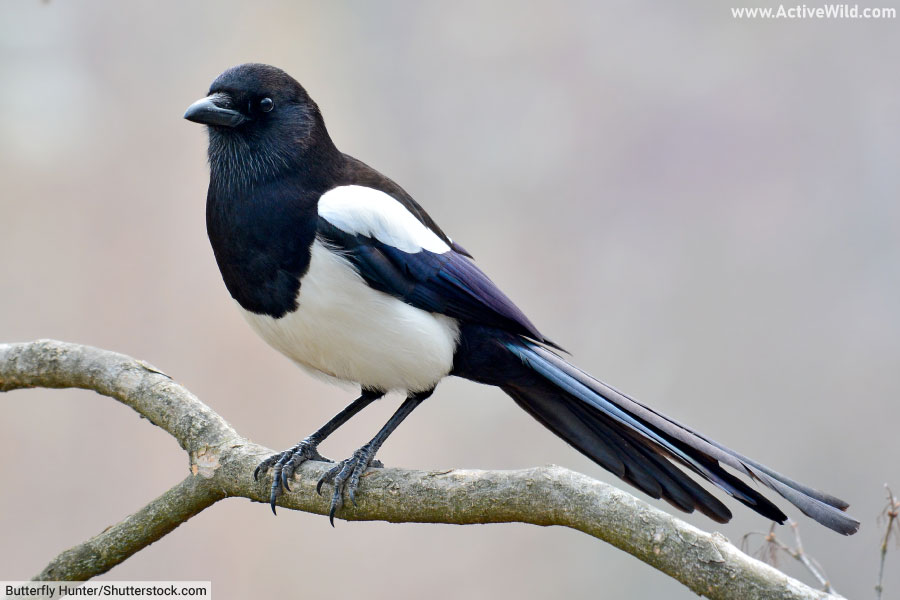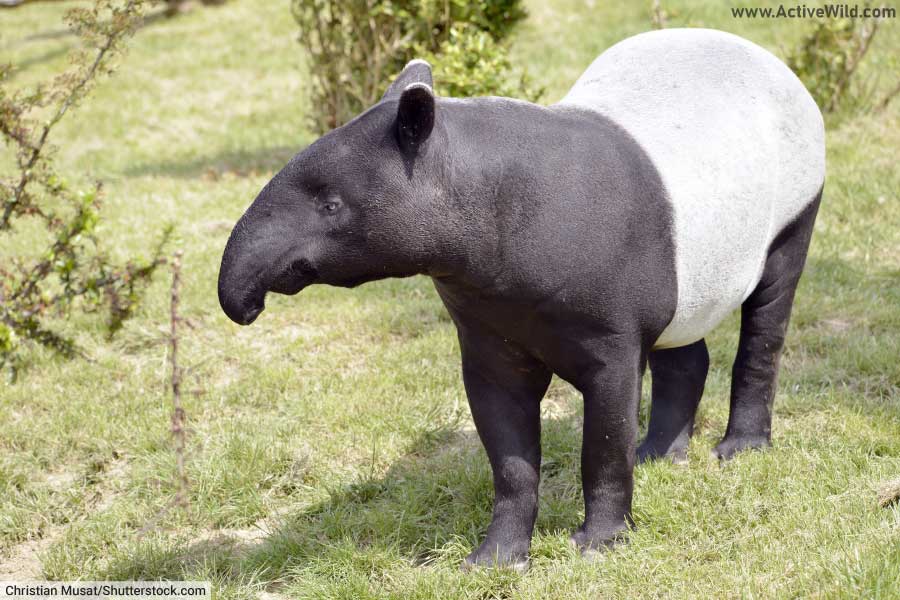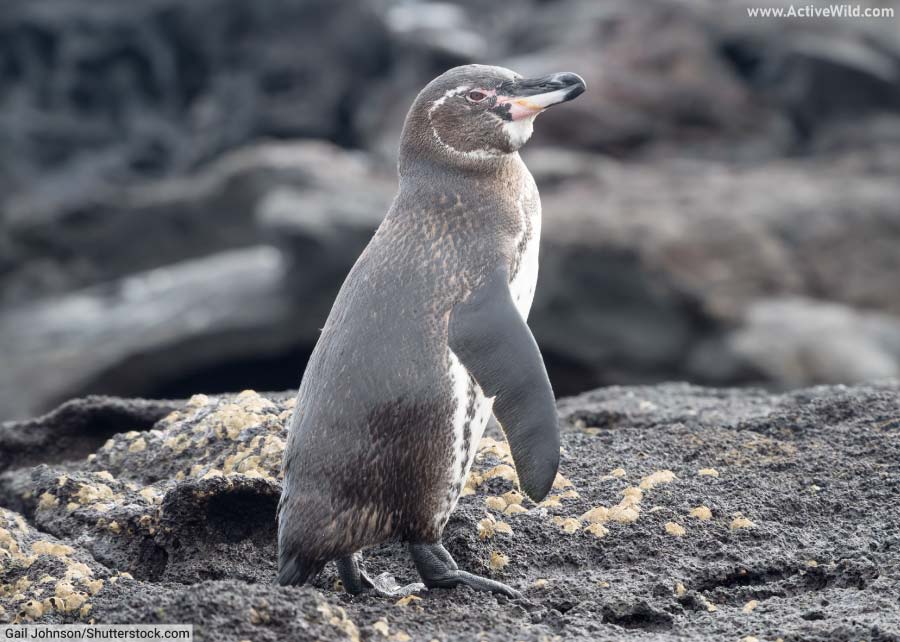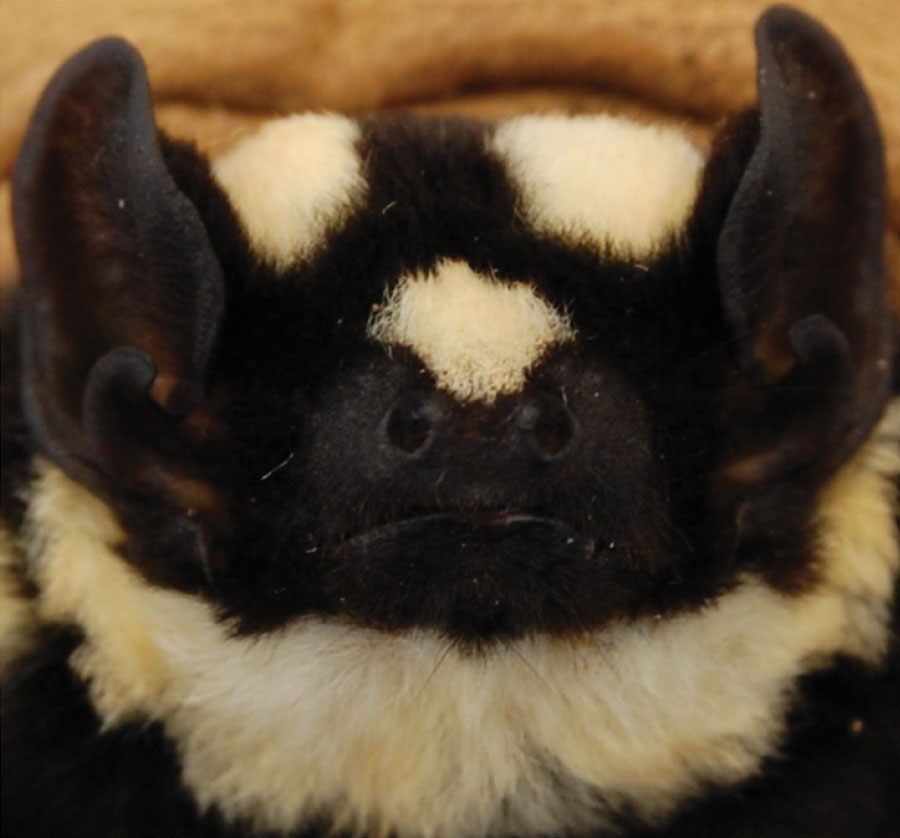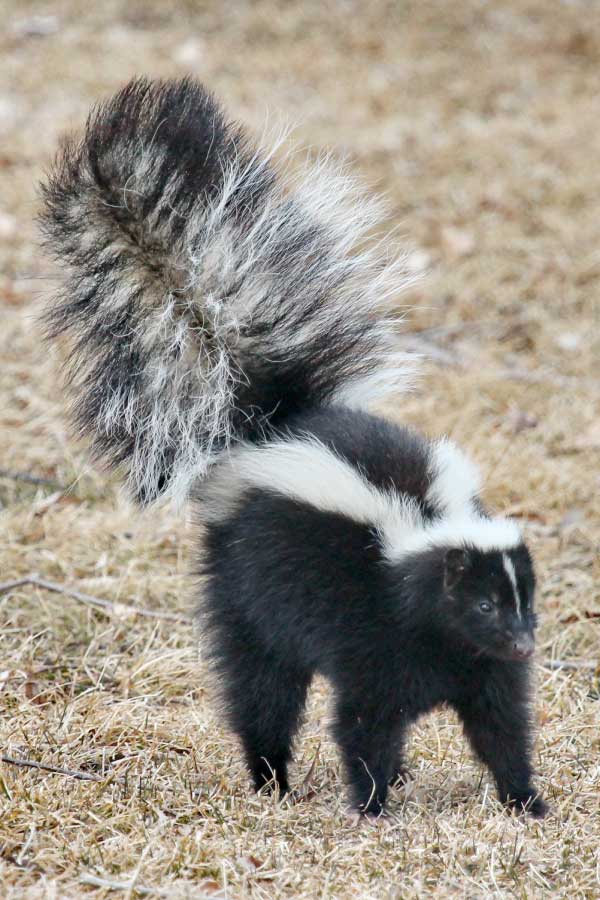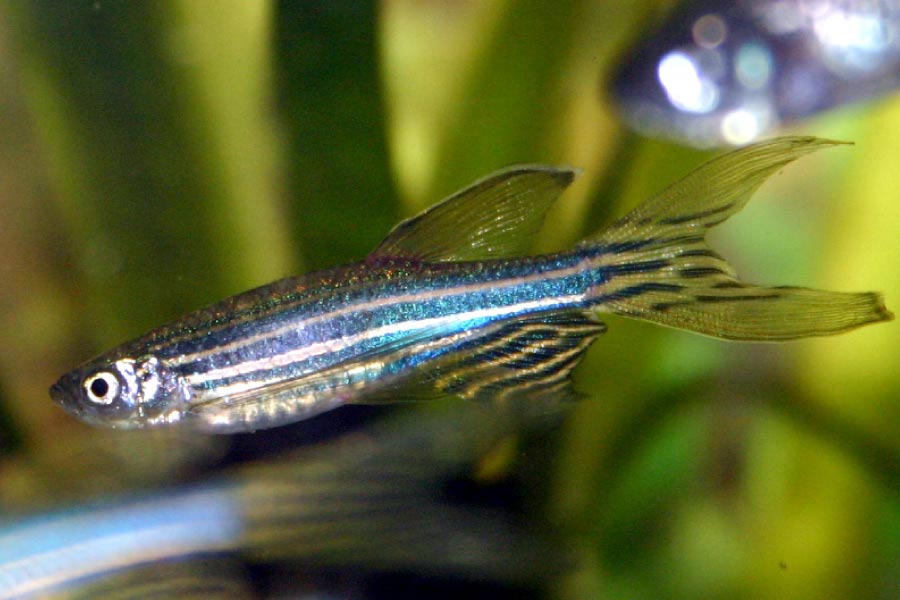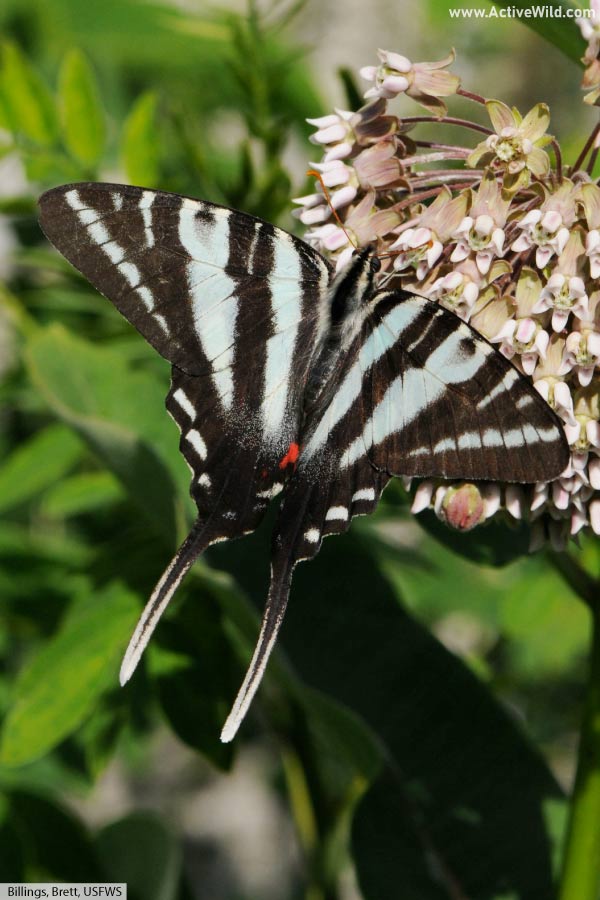Black And White Animals
Examples of black and white animals include mammals such as zebras, pandas and killer whales / orcas; birds such as magpies and penguins; and insects such as the banded alder borer beetle and zebra swallowtail butterfly.
Pictures and facts on these and many other amazing black and white species can be found in the list below.
(Click here to go straight to the list.)
Why Are Some Animals Black And White?
Although black and white may seem to be a rather dull color combination, it is actually a visually striking, and relatively rare, color scheme in animals.
Black and white coloration in animals serves a number of evolutionary purposes, including camouflage and aposematism.
Aposematism is a visual warning to potential predators. The markings of several black and white animals, including the skunk and honey badger, warn potential predators that the animals are not worth attacking, either because they taste bad or because they are well-defended.
If, for example, a young coyote attacks a skunk, the skunk will defend itself by spraying the coyote with a foul-smelling chemical. After one or two similar encounters, the coyote will begin to associate the aposematic black and white coloration with the foul-smell, and will be hesitant to attack a skunk in the future.
Black and white coloration can also serve as camouflage; the Malayan tapir’s markings are thought to help to break up its body shape in the forest.
A zebra’s distinctive black and white stripes may have evolved to confuse potential predators; a lion might find it harder to attack a single zebra in a herd if all it can see is a wall of moving black and white stripes.
(In fact, there is some debate over the reason for a zebra's black and white coat; another potential explanation is that the stripes deter disease-carrying flies from landing on the zebra's skin.)
Black And White Animals List with Pictures And Facts
The conservation status of each animal comes from the IUCN Redlist. (Source)
Argentine Black And White Tegu
- Type of animal: Reptile
- Family: Teiidae
- Scientific name: Salvator merianae
- Conservation status: Least Concern
The Argentine black and white tegu is a species of lizard found in Argentina, Brazil, and several other South American countries. This black and white reptile lives in a variety of habitats, including forests and savannas, and is present in the Cerrado – a large forest and savanna ecoregion in Brazil. (See Wikipedia)
Unlike the vast majority of reptiles, the Argentine black and white tegu is not entirely ectothermic (cold-blooded). During the mating season, the species becomes endothermic (warm-blooded), keeping the temperature of its body higher than that of its surroundings.
This intelligent reptile is sometimes kept as a pet, and can even be house-trained.
Asian Black Bear
- Type of animal: Mammal
- Family: Ursidae
- Scientific name: Ursus thibetanus
- Conservation status: Vulnerable
The Asian black bear is one of eight living bear species. Although primarily black, the species has a large white, V-shaped patch on its chest. The Asian black bear is also known as the “moon bear” and “white-chested bear” due to its distinctive markings.
This Asian ursid is arboreal (tree-dwelling), and lives in forests in southern and Southeast Asia. It is an omnivore, eating a variety of fruit, nuts and other plant material, as well as hunting or scavenging for meat.
The species’ vulnerable status is due in part to deforestation, and in part to being hunted by humans for its body parts, which are used in traditional Asian medicine.
- You can find out more about the Asian black bear on this page: Asian Black Bear Facts
- You can find out more about bears on this page: Bears: The Ultimate Guide
Bald Eagle
- Type of animal: Bird
- Family: Accipitridae
- Scientific name: Haliaeetus leucocephalus
- Conservation status: Least Concern
The bald eagle is one of the world’s most recognizable birds, due to its black and white plumage and yellow bill, eyes and feet.
This large avian predator is the national bird of the USA, and is also found in Canada and northern Mexico.
The bald eagle lives in a variety of habitats and feeds mainly on fish, which are captured in the bird’s powerful talons as it dives into the water.
This iconic American bird was once in danger of extinction due to over-hunting and the widespread use of the pesticide DDT.
A number of conservation measures saw the species’ population recover from the mid-20th century onwards, and today it has the conservation status of “Least Concern”; one of the few conservation success stories.
- You can find out more about the bald eagle on this page: Bald Eagle Facts
Banded Alder Borer Beetle
- Type of animal: Insect
- Family: Cerambycidae
- Scientific name: Rosalia funebris
- Conservation status: Currently Unassessed
The banded alder borer is a black and white beetle found in the western United States. It is a member of the longhorn beetle family, Cerambycidae.
Like most other members of its family, the banded alder borer has long antennae, which can be more than double the length of its body.
The banded alder borer can be found not just on alder trees, but also on willows, ash and other species. The beetle lays its eggs on the bark of a dead tree. Once hatched, the larvae bore into the wood.
The smell of fresh paint acts as an attractant to adult banded alder borers. This may be due to the paint having a scent similar to that of a pheromone produced naturally by the beetle.
- You can find out more about beetles on this page: Beetles: The Ultimate Guide
Black And White Warbler
- Type of animal: Bird
- Family: Parulidae
- Scientific name: Mniotilta varia
- Conservation status: Least Concern
The black and white warbler is a bird in the New World warbler family, Parulidae.
Like many warblers, it is migratory, spending the summer in the eastern United States, and overwintering in Florida, Mexico and Central America.
As well as its distinctive coloring, the black and white warbler can be identified by its habit of creeping along branches and up and down tree trunks.
Black And White Colobus
- Type of animal: Mammal, Primate
- Family: Cercopithecidae
- Genus: Colobus
- Conservation status: (see text)
There are five species of black and white colobus: the black colobus, Angola colobus, King colobus, ursine colobus and mantled colobus.
Together they make up the genus Colobus, which is part of the Old World monkey family, Cercopithecidae.
All five black and white colobuses are found in Africa, where they inhabit a variety of forest habitats.
Only the mantled guereza is unthreatened; the conservation status of the black and Angola colobus is Vulnerable; the king colobus is Endangered, and the ursine colobus is Critically Endangered.
Black And White Hawk Eagle
- Type of animal: Bird
- Family: Accipitridae
- Scientific name: Spizaetus melanoleucus
- Conservation status: Least Concern
The black and white hawk eagle is a small eagle found in forests and savannas in Central and South America. Its prey consists mainly of birds, but it will also take a wide variety of reptiles and mammals.
The eagle is known to prey on another black and white animal: the white woodpecker, Melanerpes candidus.
The black and white hawk eagle soars high above the forest in search of suitable prey. Once a target has been spotted, the eagle dives, capturing its unsuspecting victim in its claws.
Although rated as “Least Concern”, the black and white hawk eagle’s population is decreasing.
Black And White Ruffed Lemur
- Type of animal: Mammal; Primate
- Family: Lemuridae
- Scientific name: Varecia variegata
- Conservation status: Critically Endangered
The black and white ruffed lemur is one of around 100 species of lemur. Lemurs are a group of primates found only on Madagascar; an island country located on the eastern coast of Africa.
This black and white primate is one of two species of ruffed lemur, the other being the red ruffed lemur. The two primates are the only members of the genus Varecia.
The black and white ruffed lemur is arboreal (tree-dwelling). Its population is patchily-distributed over a large area of rainforest in eastern Madagascar.
The conservation status of the black and white ruffed lemur is “Critically Endangered”. This is due mainly to habitat loss caused by traditional slash and burn agriculture, logging and mining.
- You can find details on other critically endangered animals on this page: Critically Endangered Species List with Pictures & Facts
Common Murre / Guillemot
- Type of animal: Bird
- Family: Alcidae
- Scientific name: Uria aalge
- Conservation status: Least Concern
The common murre, known as a guillemot in the British Isles, is a large seabird found in both the North Atlantic and North Pacific. It is one of 24 birds in the auk family, Alcidae (other members of this family include puffins and the razorbill).
The common murre, with its black and white coloration, poor maneuverability on land and excellent swimming ability, shares many similarities with penguins.
The birds are not closely related, however: the similarities are a result of convergent evolution – the process by which unrelated species evolve similar characteristics.
In fact, a common murre would never naturally be seen with a penguin, as penguins are found almost exclusively in the Southern Hemisphere. In addition, all living auks (including the common murre) can fly, unlike the flightless penguins.
Dall’s Porpoise
- Type of animal: Mammal; Cetacean
- Family: Phocoenidae
- Scientific name: Phocoenoides dalli
- Conservation status: Least Concern
Dall’s porpoise is one of eight living porpoises, which together form the family Phocoenidae.
The family is part of a larger group of marine mammals known as toothed whales. This group also contains dolphins, the killer whale, and several other types of whales.
Toothed whales such as Dall’s porpoise have teeth and actively hunt their prey, unlike their relatives the baleen whales, who filter food from the seawater.
Dall’s porpoise is found in the North Pacific. It lives in small pods of between 2 and 10 individuals and feeds on fish and squid. It is sometimes seen swimming with killer whales, but is also known to be hunted by the larger species.
Dalmatian Dog
- Type of animal: Mammal
- Family: Canidae
- Scientific name: Canis lupus familiaris
- Conservation status: Domestic
The Dalmatian is a breed of dog known for its distinctive white and black-spotted coat.
Dalmatians are medium-large dogs that are highly energetic and playful. They make good family pets, although can be a little boisterous for those with very young children.
The breed originated from Dalmatia, a region in western Croatia situated on the Adriatic Coast.
- You can find out more about dogs on this page: Dog Facts
European Badger
- Type of animal: Mammal
- Family: Mustelidae
- Scientific name: Meles meles
- Conservation status: Least Concern
One of the most famous black and white animals found in Europe is the European badger. This nocturnal species lives in woodlands across most of the continent. Its range also extends into western Asia.
The European badger lives in burrows known as setts, which it digs with its powerful limbs and claws. It is an omnivore whose diet includes fruit, cereals, earthworms, insects and small mammals.
The European badger is one of several species of badger, all of which belong to the weasel family, Mustelidae.
Giant Leopard Moth
- Type of animal: Insect
- Family: Erebidae
- Scientific name: Hypercompe scribonia
- Conservation status: Currently Unassessed
The giant leopard moth is a species of moth found in North America from southern Canada to Panama.
It is a large moth, with males having a wingspan of up to 3.6 in. / 91 mm (females are significantly smaller). The white wings of individuals of both sexes are patterned with distinctive black circles and spots.
Like most moths, the giant leopard moth is nocturnal.
In its larval (caterpillar) stage, the giant leopard moth is around 3 in. / 75 mm in length, and covered with thick hair-like bristles known as setae (only mammals have true hair).
“Hairy” caterpillars such as these are known as “woolly bears”.
- Confused by moths and butterflies? Check out this page: The Difference Between Butterflies & Moths
Giant Panda
- Type of animal: Mammal
- Family: Ursidae
- Scientific name: Ailuropoda melanoleuca
- Conservation status: Vulnerable
One of the world’s most famous black and white animals is the giant panda. The panda (the “giant” part of its name is often omitted) is found in mountain forests in South Central China.
The species is one of eight living species of bear, and the most herbivorous; its diet consists almost entirely of bamboo shoots.
The panda has a bony projection on each hand that serves as an extra digit. These are used to grip bamboo stalks as the panda eats.
Another adaptation the giant panda has for eating bamboo is its powerful jaw muscles, which give the animal its distinctive round face.
- You can find out more about the giant panda on this page: Panda Facts
- You can find out more about bears on this page: Bears: The Ultimate Guide
Holstein Friesian Cattle
- Type of animal: Mammal
- Family: Bovidae
- Scientific name: Bos taurus
- Conservation status: Domestic
Holstein Friesian cattle are typically known as “Holsteins” in North America, and “Friesians” in the British Isles. They are the typical black and white cows seen in fields on both sides of the Atlantic.
Holstein Friesian cattle are kept as milk-producing dairy cows and are the world’s most widely-distributed cattle breed. European “Friesian” cows are also raised as beef cattle.
All cows belong to the cattle family, Bovidae, which is also home to numerous other hoofed animals, including bison, buffalo, antelopes, sheep and goats. Members of this family are known as “bovids”.
Honey Badger
- Type of animal: Mammal
- Family: Mustelidae
- Scientific name: Mellivora capensis
- Conservation status: Least Concern
The honey badger is a member of the weasel family, Mustelidae. This group of carnivoran mammals also includes animals such as otters, weasels, and the wolverine.
Found throughout much of Africa and in parts of Asia, the honey badger is an adaptable species, able to live in a variety of habitats ranging from rainforests to deserts.
The honey badger is known for its toughness and ability to take on animals much larger than itself.
The species is an active hunter, but will also scavenge when the chance presents itself.
Despite its fearsome reputation, the honey badger is not an apex predator and will fall victim to lions, leopards and hyenas.
- You can find out more about the honey badger on this page: Honey Badger Facts
Killer Whale
- Type of animal: Mammal; Cetacean
- Family: Delphinidae
- Scientific name: Orcinus orca
- Conservation status: Data Deficient
The killer whale, also known as the orca, is a large black and white marine mammal. It is the largest member of the oceanic dolphin family, Delphinidae.
Delphinidae is part of a larger group of marine mammals, the toothed whales. This group contains dolphins, porpoises, and several other whale species, including the sperm whale.
The killer whale is a social animal that lives and hunts in groups known as “pods”. Its diet includes fish, seals, dolphins and even whale calves.
The species is found in all of the world’s oceans, usually inhabiting colder waters where food is abundant.
- You can find out more about the orca on this page: Killer Whale Facts
Magpies
- Type of animal: Bird
- Family: Corvidae
Magpies are members of the crow family, Corvidae. This family also includes birds such as crows, ravens and jays.
Several magpie species have black and white plumage. These include the black-billed and yellow-billed magpies, both of which are found in North America, and the Eurasian magpie, which is found throughout much of Eurasia.
On closer inspection, a magpie’s plumage has a colorful (and very beautiful) metallic sheen.
The Eurasian magpie is considered to be not just one of the most intelligent birds, but also one of the most intelligent of all animals.
This clever crow is one of the very few animals able to pass the mirror test. In order to pass this test, an animal must be able to identify itself from its reflection.
Malayan Tapir
- Type of animal: Mammal
- Family: Tapiridae
- Scientific name: Tapirus indicus
- Conservation status: Endangered
The Malayan tapir is the only member of the tapir family Tapiridae not found in the Americas. The species inhabits tropical rainforests on the Malay Peninsula and the Indonesian island Sumatra in Southeast Asia.
The black and white coloration of the Malayan tapir acts as camouflage, breaking up the animal’s outline to conceal its presence from predators.
The animal’s size and considerable power are further deterrents. Full-grown Malayan tapirs are rarely preyed on, despite living alongside fearsome predators such as tigers and leopards.
- You can find out more about tapirs on this page: Tapir Facts
Penguins
- Type of animal: Bird
- Family: Spheniscidae
Penguins are a family, Spheniscidae, of flightless seabirds found mainly in cold areas in the Southern Hemisphere; several species are present on Antarctica’s frozen coastline
Only one penguin species, the Galápagos penguin, is found in the northern hemisphere, and it is restricted to the Galápagos Islands, which straddle the Equator.
Although clumsy on land and unable to fly, penguins are excellent swimmers, able to use their short, powerful wings to “fly” through the water.
Several penguin species have touches of yellow or red on either their bills, feet, heads or chests, but all are predominantly black and white.
A penguin’s white undersides and black back are an example of countershading – a form of camouflage that conceals an animal both from above and below.
A predator underneath a swimming penguin will have difficulty seeing the bird against the sky; from above, a predator will have difficulty seeing the penguin against the dark water or sea bed.
- You can find out more about the different types of penguins on this page: Types Of Penguins With Pictures & Facts
Pied Butterfly Bat
- Type of animal: Mammal
- Family: Vespertilionidae
- Scientific name: Glauconycteris superba
- Conservation status: Least Concern
The pied butterfly bat (also known as the pied bat) is a small bat found in Africa. It inhabits dense tropical forests.
Countries in which this rare and seldom-seen species is known to be present are The Democratic Republic of the Congo, Côte d'Ivoire and Ghana.
The pied bat has distinctive white / pale yellow blotches on its body, giving it a bee-like appearance. Badger-like markings on its face give it the alternative name “badger bat”.
Like all bats, the pied bat is a mammal. Bats are not related to birds; bats and birds evolved the ability to fly independently of each other.
- You can find out more about bats on this page: Bats: The Ultimate Guide
Skunks
- Type of animal: Mammal
- Family: Mephitidae
Skunks, along with the two species of stink badger, make up the animal family Mephitidae.
There are 10 skunk species, all of which are only found in the Americas (the two stink badgers are found in Southeast Asia).
Most skunks are black and white in color. The distinctive markings act as a warning to other animals that a skunk is well able to defend itself.
Skunks are well-known for their ability to spray a foul-smelling liquid from their scent glands in order to deter a potential attacker. This defense mechanism is highly-effective, and will protect the skunk from animals as large as a bear.
A skunk’s coloration is an example of aposematic coloration. This is when an animal’s coloration or markings tell potential predators that it is not worth eating.
Zebras
- Type of animal: Mammal
- Family: Equidae
Zebras are members of the horse family, Equidae. These distinctive black and white striped animals are found in Africa. There are three living zebra species: the plains zebra, mountain zebra and Grévy's zebra.
Numerous hypotheses have been put forward to explain the zebra’s distinctive stripes. These include camouflage, a means of visually confusing predators such as lions, or a means of controlling body temperature.
Another theory suggests that a zebra’s stripes deter flies from landing on its body. Because insects such as flies spread disease, this would be a valuable evolutionary development.
The conservation status and scientific name of each zebra species is shown below:
Zebra Species
- Plains zebra Equus quagga: Near Threatened
- Mountain zebra Equus zebra: Vulnerable
- Grévy's zebra Equus grevyi: Endangered
The plains zebra is the most common and widespread of the three zebra species (it is also known as the “common zebra”). It is found in grasslands and savannas across sub-Saharan Africa.
The mountain zebra is found in Angola, Namibia and South Africa in southwestern Africa. It is usually found in grassy mountainous terrain.
With a population consisting of under 2,000 adult individuals, Grévy's zebra is an endangered species. It is found in dry grasslands and shrublands in Ethiopia and Kenya.
Grévy's zebra is both the largest zebra species and the largest wild horse species.
- You can find out more about zebras on this page: Zebra Facts
Zebrafish
- Type of animal: Fish
- Family: Cyprinidae
- Scientific name: Danio rerio
- Conservation status: Least Concern
The zebrafish is a black and white freshwater fish found in the wild in South Asia. It is a popular aquarium fish, and is also known as the Zebra Danio by fish-keepers.
The species is a member of the carp and minnow family, Cyprinidae.
The zebrafish is much-studied due to its ability to grow back heart, and eye cells while in its larval stage.
Zebra Swallowtail Butterfly
- Type of animal: Insect
- Family: Papilionidae
- Scientific name: Protographium marcellus
- Conservation status: Currently Unassessed
The zebra swallowtail is a large black and white butterfly found in the eastern United States and south-eastern Canada. It is the state butterfly of Tennessee.
Like many members of the swallowtail butterfly family, Papilionidae, the zebra swallowtail has a long tail streamer extending from each of its hind wings.
The zebra swallowtail usually lays its eggs on the leaves of pawpaw trees. The eggs are laid singly because the caterpillars are cannibalistic and may eat one another.
- Confused by moths and butterflies? Check out this page: The Difference Between Butterflies & Moths
Black And White Animals List: Conclusion
We hope that you have enjoyed discovering these amazing species. What’s your favorite black and white animal? Have we missed any out?
Let us know by leaving a comment below!
You can discover more amazing animals on these pages:

